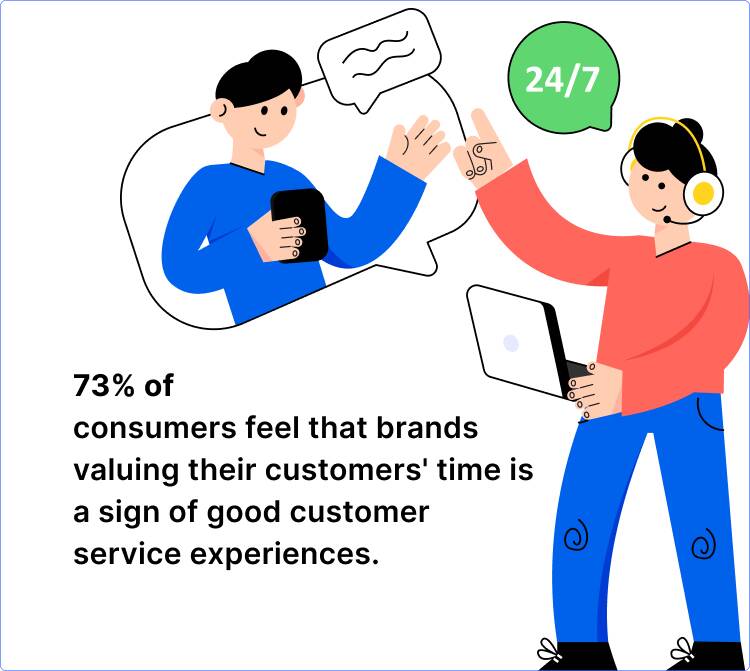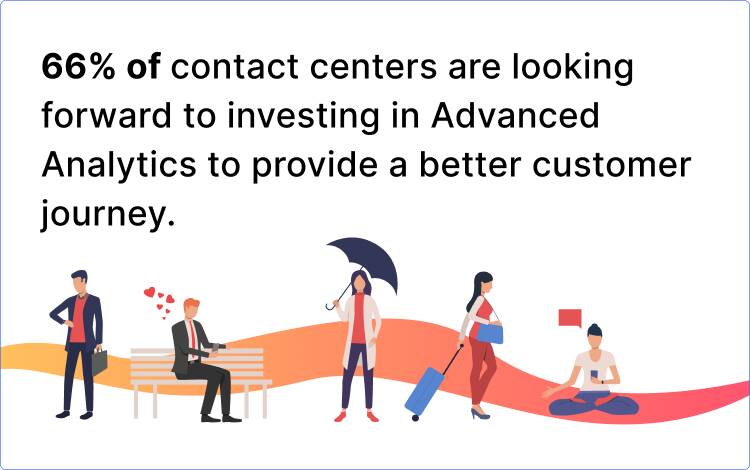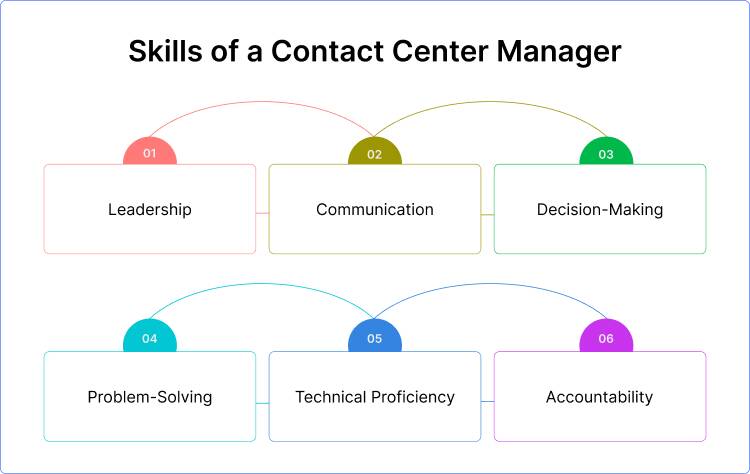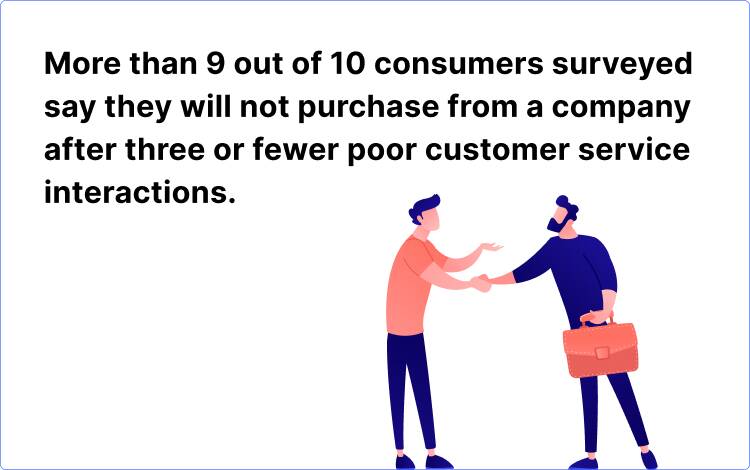
Do you often feel that your contact center is overwhelmed with ringing phones, frustrated customers, and agent turnover? Juggling with hundreds of agents, fluctuating contact center metrics, outdated tools, and forecasts can leave the most seasoned managers feeling worrisome. This article is your guide to some practical contact center management strategies that are simple to implement yet deliver effective results.
We’ll explore the core responsibilities of a contact center manager, key areas to focus upon for effective call center management, and a bundle of bonus tips as well.
Let’s begin!
What is Contact Center Management?
Contact Center Management is about strategically overseeing the daily operations within a customer contact center environment. The major focus is on three key areas:
- Optimizing customer experience or CX
- Maximizing operational efficiency
- Utilizing the right technology
Contact Center Management Example
Let’s understand the concept of contact center management with an example.

ABC Telecom’s Contact Center
You are a telecom company that offers internet and phone services. Your company has a contact center to manage customer inquiries, and complaints and provide technical support to customers.
Challenge: Suppose your contact center experiences a sudden surge in calls during a major service outage.
Solution: Here’s how effective call center management addresses this situation:
- Hiring more Agents
To handle the current surge in call volume, more contact center agents are hired. It is ensured that the agents receive real-time updates about the outage so that they can provide the latest information to customers.
- Updated Systems
Your contact center’s IVR system is updated to inform callers about the outage along with an estimated resolution time. This helps in reducing the number of calls that need to be handled by agents.
- Dedicated Outage Team
A specialized team is assigned to focus solely on issues related to the outage, ensuring quick escalation and swift resolution of complex issues.
- Data Analytics and Reporting
Through real-time dashboards, managers keep track of call volumes, wait times, and customer sentiment.
We have explored the inner workings of contact center management, it’s important to recognize who ensures these operations run smoothly. The contact center manager fulfills this crucial role. Let’s delve into the role and responsibilities of a contact center manager in the next section.
Key Responsibilities of Contact Center Manager
A contact center manager wears many hats. Let’s break down the core responsibilities of a contact center manager, one by one along with examples:
Managing The People
For contact center managers, their people are the agents who interact with their customers and prospects.
Recruitment and Training of the Agents
The first and foremost core responsibility of contact center managers is to hire qualified agents and ensure they receive comprehensive training. For example, a manager conducts role-playing exercises to equip agents with the skills to handle complex customer inquiries.
Agent Performace Management
Another key responsibility of a contact center manager is to evaluate agent performance regularly. Call monitoring is an effective way to calculate and review KPIs i.e. key performance indicators such as average call handling time and customer satisfaction scores. For example, a manager reviews call recordings to judge the agents’ product knowledge.
Motivation and Engagement of the Agents
It is another crucial responsibility area of contact center managers. They need to create and maintain a positive and motivating work environment. This is important for agent retention. Team building exercises, recognition, and reward programs are some ways to motivate and engage agents. For example, a manager implements a “Customers’ Favorite” program to recognize agents who consistently receive high customer satisfaction ratings.
Maintaining Operational Efficiency
Managing the Workforce

Scheduling the right number of agents to meet call volume demands effectively is a key responsibility of a contact center manager. For example, a manager, based on historical data and trends, schedules more agents during peak hours to minimize wait times and ensure prompt responses to calls.
Improving the Process
To maintain the efficiency of the contact center, it is essential to constantly evaluate and refine internal processes. This includes streamlining call routing procedures, deploying automation for repetitive tasks, and implementing self-service options. For example, a contact center manager implements a new system to expedite handling returns as a solution to a problem in order processing, thus minimizing customer frustration and wait times.
Utilizing Technology

(Source- Invoca)
Staying up-to-date with the latest tools and technologies is a must for contact center managers. Switching to modern cloud contact center solutions and implementing technologies such as call routing, chatbots, data analytics, etc., can accelerate contact center operations. For example, a manager implements a chatbot on the company website to answer basic customer queries such as order tracking, freeing up agents to handle more intricate issues.
Delivering Excellent Customer Experience
Setting Service Standards
$1.6T is lost every year in the U.S. because of poor customer service. (Source – Invoca)
Another key area where a contact center manager needs to focus is determining and maintaining clear service level agreements (SLAs) for call response times, customer satisfaction, and resolution rates. For example, a contact center manager sets a target of answering 85% of calls within 30 seconds and achieving a 90% customer satisfaction rate.
Assuring Quality of Service
The role of contact center managers also involves the responsibility of ensuring that agents adhere to company protocols when interacting with customers over calls. For example, a manager listens to the call recordings and provides feedback to agents on areas like clear communication, problem-solving, and empathy.
Essential Skills Required for Good Contact Center Management

We’ve discussed the responsibilities of a contact center manager, but how does one wear all those hats and excel? The answer lies in mastering a unique blend of skills, which are as follows:
Leadership Skills
A good contact center manager should inspire and motivate agents to deliver excellent customer service. Managers should coach the agents with a clear direction, regular and genuine feedback, and provide them with opportunities for professional learning. Additionally, managers need to take care of conflict resolution. They should have the ability to maintain a positive work environment and resolve issues effectively.
Tips
- Clearly define roles and responsibilities for each team member.
- Encourage open communication and actively listen to agent concerns.
- Provide ongoing coaching and feedback to help agents develop their skills.
- Recognize and reward agent accomplishments to boost morale and motivation.
Communication Skills
A good contact center manager should be able to clearly communicate the expectations, policies, and procedures to his team. Moreover, active listening skills are a must for this type of role. Contact center managers can address challenges proactively by listening attentively to customer feedback, agent concerns, and ongoing trends.
Tips
- Schedule regular team meetings to discuss performance, goals, and challenges.
- Provide clear and specific feedback to agents during meetings.
- Practice active listening skills when communicating with agents and customers.
Decision Making and Problem Solving Skills
Contact centers encounter unexpected situations daily. An efficient manager should have a strategic vision and the ability to think critically to find solutions to problems. They need to base their choices on solid facts and figures.
Tips
- Stay informed about industry trends.
- Analyze customer feedback and key performance indicators (KPIs).
- Set clear long-term goals aligned with the company’s strategy.
- Be open to exploring innovative solutions with the team.
Technical Proficiency
To ensure optimized workflows, a contact center manager must be familiar with the technology involved. From call routing to integration with CRM, managers must know how to leverage the capabilities of a hosted contact center system and its various features. Further, a manager should be able to interpret data from various sources such as customer feedback, call recordings, etc. This ability helps in tracking progress and identifying areas for improvement.
Accountability
Contact centers run in a dynamic environment where mistakes are often inevitable. A strong contact center manager takes ownership of the problems and works towards finding the solution to those problems. They analyze the root cause of mistakes and develop a plan to prevent recurrence.
Tips
- Openly discuss challenges with the team and encourage them to share solutions.
- Celebrate successes and acknowledge the team’s efforts in overcoming challenges.
Best Strategies to Successfully Manage Your Contact Center
Needless to say, a well-run contact center is no longer a luxury, it’s a necessity. It significantly shapes brand perception and directly impacts customer loyalty. To ensure operational excellence and customer satisfaction, let’s take a look at the best strategies to successfully manage your contact center.
Be Customer Centric

Make ‘Customer Satisfaction’ the main focus for all contact center decisions. Some key strategies to follow are:
- Offer seamless customer service across multiple channels like phone, email, chat, and social media. 66% of customers use at least three communication channels to reach customer service.
- Train your agents to resolve customer issues effectively on the first call i.e. First Call Resolution, minimizing repeat calls, and improving customer happiness.
- Practice an active approach to gathering and analyzing customer feedback. Conduct surveys, listen to call recordings, and review social media mentions to analyze customer sentiment.
Example: Create a comprehensive knowledge base that includes detailed troubleshooting tutorials, FAQs, and product manuals. Make sure access to this knowledge base is readily available during calls. Further, investing in frequent training sessions helps ensure that agents are up-to-date on products, services, and best practices for handling customer interactions.
Also, you can use sentiment analysis tools to figure out the pain points and preferences of the customers. Such data can help refine training programs, personalize marketing campaigns, and improve various other areas.
Empower Your Agents
60% of agents agree that their company doesn’t always provide the technology that staff needs to address customer challenges. ( Source )
No matter how good your contact center management skills are, if your agents do not have the right knowledge and tools at their disposal, your efforts will go in vain. You should therefore invest in your agents.
- Hire qualified agents with strong communication, problem-solving, and empathy skills.
- Provide comprehensive onboarding and ongoing training programs to equip them with the knowledge and tools they need to excel.
- Implement a system for regular performance reviews and coaching sessions.
- Create a positive and motivating work environment by recognizing and rewarding agent achievements.
Integrate Call Center Software with Other Tools
58% of US customers are willing to pay a premium to a brand that can deliver a superior customer experience. (Source – Invoca)
Integrating your call center technology with other business tools helps in creating more efficient operations as well as empowers agents to deliver exceptional customer service with every single call.
- Integrate your CRM software with your contact center software. Such integration provides agents with access to all customer data at their fingertips such as name, purchase history, and past interactions. Ultimately, agents can provide personalized interactions such as greeting customers by name, resolving issues faster, and delivering a seamless experience.
- Integrate your contact center software with your e-commerce platform so that agents have instant access to complete order details. Whether it is about initiating returns or checking order status, agents can do that directly within the contact center interface, eliminating the need for customers to repeat information and saving them time.
- Social media is often the first point of contact for customer queries. It is a good practice to integrate your social media accounts with your contact center software. Agents will be able to address customer issues directly from the contact center platform, resulting in a faster and more convenient resolution experience.
- Integrate your knowledge base so that agents can guide customers to relevant articles, FAQs, tutorials, and troubleshooting guides while interacting over the call. This empowers customers to self-serve and reduces call volume, freeing up agents for more complex inquiries.
Stay Complaint to Stay Ahead
The customer service landscape is full of rules and regulations. As an efficient contact center manager, you just simply cannot miss complying with these regulations.
- Regularly review national and international privacy guidelines to ensure adherence to the latest standards and safety of customer data.
- Equip your team with the knowledge they need to stay compliant. This helps in eliminating accidental regulatory violations.
- Regulations, where customer consent is required, should be incorporated into agent training sessions.
Define Call Center Etiquette Guidelines for Agents
Developing an etiquette guideline doesn’t necessarily mean that agents need to follow a robotic behavior, rather they need to be respectful and professional as they interact with customers. Here’s how to establish call center etiquette guidelines:
- Agents should greet customers with respectful language.
- Agents must practice active listening so that they understand customer concerns properly.
- The usage of jargon or overly casual language should be avoided.
- Agents must stick to politeness and empathy during tense situations. For example, “Let me see if I can find a way to rectify this.”
Ask for Agent Feedback
While what your customers feel about your product and service is important, the voice of your agents i.e. concerns and suggestions of the agents are equally crucial. They have the
‘behind-the-scenes’ view of your entire contact center operations. That is why their likelihood of identifying operational bottlenecks and suggesting improvements to internal workflows is quite high.
By actively incorporating agent feedback, you might come across insights that can improve your contact center operations.
- Schedule regular check-ins with agents to discuss common customer issues, identify areas for improvement, and gather suggestions for process optimization.
- Conduct employee surveys to gather real-time feedback. Keep the survey short and quick so that agents can share their thoughts easily. Make sure you regularly monitor these surveys to identify ongoing trends and areas for improvement.
- Regularly check online review platforms like Glassdoor. You may find both positive and negative reviews highlighting specific agents or practices that need improvement.
Sales and Support Collaboration
Breaking down the information silos between the sales and support teams can help you in laying the foundation for exceptional customer service. How? Well, sales departments deal with customers and gather valuable customer insights. Sharing this data with the support department can enable agents to develop targeted solutions for customer needs and pain points.
This unified approach ensures a seamless customer journey right from the initial contact to the post-purchase experience.
Businesses that break down silos between sales and support are 6.7 times more likely to see an increase in customer lifetime value. (Source – Sprinklr)
Here’s how you can do it.
- Conduct regular meetings between sales and support teams.
- Foster a culture of shared success through reward programs between departments.
- Enable access to customer data seamlessly by implementing a unified CRM.
Top Contact Center Metrics to Measure
Out of all the roles and responsibilities of a contact center manager, what’s the most challenging one? Certainly, it’s to measure the performance of their agents and the behavior of their customers.
But is there any one way to do that?
Well, keeping track of contact center metrics is a simple and effective way to measure how well your contact center is performing. Let’s take a look at some of the most crucial contact center measures:
Average Handle Time (AHT)
AHT measures the average time it takes to handle a customer inquiry, from the moment the agent answers the call to the time they hang up. A lower AHT is generally desired, but it should be balanced with maintaining quality customer service. The ideal AHT depends on your specific industry and the complexity of your inquiries.
How to Calculate AHT?
Formula —
AHT = Total Talk Time + Total After-Call Work Time / Number of Calls Handled
Note- Talk Time refers to the total duration of the conversation between the agent and the customer. After-call work time is the time an agent spends on post-call activities like documenting the interaction and updating CRM systems.
Missed and Declined Calls
These are the number of calls that either go unanswered or are declined by agents due to being unavailable. Again, a low missed and declined call rate indicates sufficient agent availability to handle call volume. Analyze these metrics alongside wait times to identify staffing needs.
How to Calculate Missed and Declined Calls?
Formula —
Missed Call Rate: Number of Missed Calls / Total Call Volume x 100
Declined Call Rate: Number of Declined Calls / Total Call Volume x 100
Transfer Rate
Transfer rate measures the percentage of calls that are transferred to another agent or department for further assistance. A high transfer rate can indicate inadequate agent training or a limited knowledge base. Analyze transfer reasons to identify areas where improvement is needed.
How to Calculate Transfer Rate?
Formula —
Transfer Rate = Number of Transferred Calls / Total Call Volume x 100
Call Abandonment Rate
The call abandonment rate represents the percentage of calls that customers disconnect before their call is answered or while on hold. A high abandonment rate indicates long wait times or difficulty reaching an agent. This can lead to customer frustration. Analyze this metric alongside average wait time to identify areas for improvement.
How to Calculate Call Abandonment Rate?
Formula —
Call Abandonment Rate = Number of Abandoned Calls / Total Call Volume x 100
First Contact Resolution (FCR) Rate
FCR measures the percentage of customer inquiries that are resolved during the initial call with an agent. A high FCR rate indicates that agents are effectively resolving customer issues on the first try. This reduces customer effort and improves satisfaction.
How to Calculate FCR?
Formula —
FCR Rate = Number of Calls Resolved on First Contact / Total Call Volume x 100
Customer Satisfaction (CSAT) Score
CSAT score gauges customer satisfaction with the service they received from your contact center. It’s typically measured through surveys sent after interactions. A high CSAT score indicates positive customer experiences. Regularly monitor and analyze CSAT scores to identify areas for improvement.
How to Calculate CSAT Score?
Formula —
CSAT scores vary depending on the specific survey methodology used. They often range from 1 (very dissatisfied) to 5 (very satisfied).
Cost per Call (CPC)
CPC calculates the average cost of handling a customer inquiry in your contact center. The preferred count for CPS is generally on the lower side. Analyze your CPC alongside other metrics like AHT and FCR to identify areas for cost optimization
How to Calculate CPC?
Formula —
CPC = Total Contact Center Costs / Total Call Volume
Bonus Contact Center Management Tips
- Don’t underestimate the power of Interactive Voice Response (IVR) systems. These automated attendants can answer basic questions, direct callers to the appropriate agent based on their needs, and even collect basic information before connecting them. This streamlines call routing, reduces wait times, and frees up agents for more complex issues.
- You can leverage speech analysis software to identify trends in customer conversations and improve agent training.
- Track Customer Effort Score (CES) to measure how easy it is for customers to resolve their issues with the contact center.
- Make sure you offer work-life balance to your agents. Practice flexible scheduling options and breaks to reduce burnout and promote a healthy work-life balance for agents.
- Provide your agents with career development opportunities to help agents grow their skills and advance their careers within the contact center.
Let’s Summarize – What is Contact Center Management?
Hiring agents and setting up your contact center infrastructure is just half the battle; contact center managers have to face a lot of challenges. From hiring and training agents to utilizing the latest technology, effective contact center management involves balancing agent well-being, operational efficiency, and customer experience. By focusing on both agent well-being and customer experience optimization, contact center managers can create a win-win situation.






















